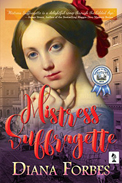
 |
With the Panic of 1893 creeping across the United States and taking its toll on her upper-class family, the life Penelope Stanton is accustomed to is fading fast. Her future hinges on the Memorial Day Ball in Newport, Rhode Island, where she meets New York millionaire banker Edgar Daggers. Aware of Penelope’s hardships, Edgar promises Penelope financial security and opportunity, but at a cost Penelope is not too comfortable with. Desperate to get away from him, she flees to Boston with a friend, where she becomes involved in the early stages of the women’s suffrage movement. Through her acquaintance and employment with Verdana and the women’s movement, Penelope begins to find both her voice and a taste of independence. But when Edgar makes his way back into her life, Penelope finds herself caught between ideologies. With her reputation on the line, Penelope must make a choice between them.
Set against the backdrop of the Gilded Age and the growing women’s suffrage movement, this novel hones in on the changing social landscape of America and what it was like for young women growing up in that time. Filled with historical detail and accuracy, Penelope’s coming-of-age story is a delightful read, both timeless and modern in its portrayal of the issues of sexism, feminism, and freedom. There are two main plot points in this book: Penelope’s search for financial independence as well as the means to help her family, and her twisted, complicated relationship with Edgar. The two tend to weave together with each one being a motivator for the other. Edgar is a potential ticket for rescuing Penelope’s family out of hardship, but his aggressive behavior also pushes her away from him and towards forging her own path. Although not wholly the reason, it is Penelope’s relationships with men—her father, her ex-fiance, Aldrich Stone, and Edgar—that help her push past the societal restrictions of what a young woman should or ought to do with regard to her future.
Interestingly enough, while Penelope and Verdana are fighting for success outside of society’s standards, the other women present in the story—Mrs. Stanton, Mrs. Daggers, and Amy Van Buren—all represent women who have earned success within society’s standards. Each of these women has influence to some degree, which they were able to achieve from their husband’s financial success. It is a trade-off that Penelope struggles with as she is courted by Edgar because she knows that it is a life of comfort and ease that she is already used to.
The author successfully displays the frenzy, excitement, and evolution of the early suffrage movement in this novel with Penelope’s involvement in it. In the beginning, Penelope is working with Verdana for the rational dress movement, lending her opinion on the pros and cons of the constricting corsets that were fashionable at the time. By the end, living in New York and working with more prominent leaders, Penelope is writing speeches and handing out pamphlets that advocate heavier issues, like women’s suffrage and rights for black men. The growth of the movement, and Penelope’s own growth, then, are mirrors of each other, shifting from superficial issues into more concrete and pressing ones. As the movement gains confidence, so does Penelope, and she blossoms into a young woman full of resolve and the suffragist spirit.